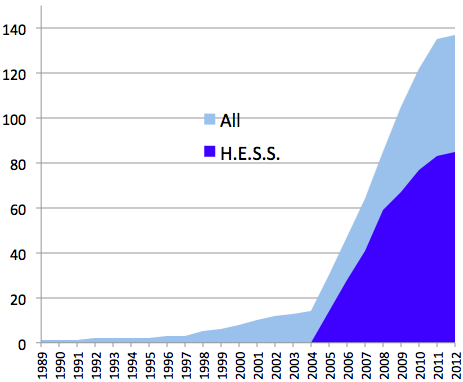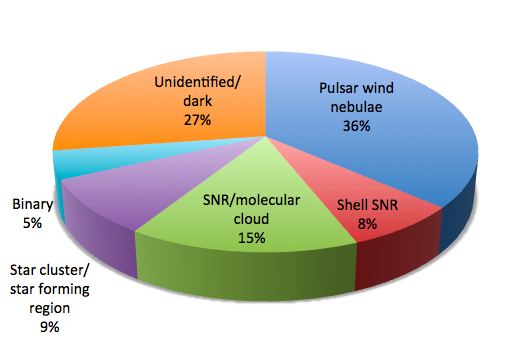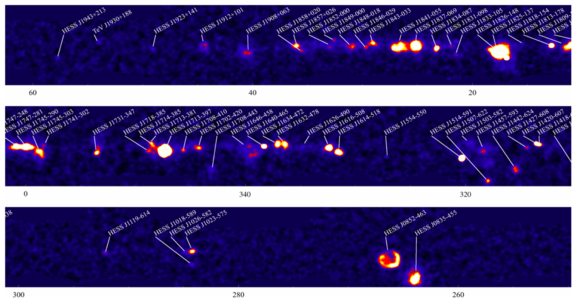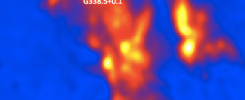September 2012
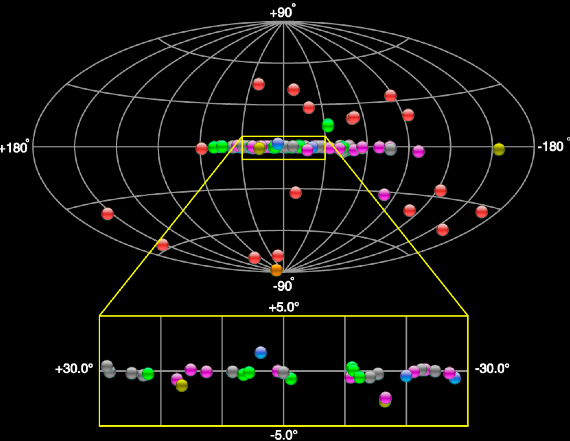
Sources of very high energy gamma rays belong to the most extreme spots in the universe. H.E.S.S. has detected and explored a large number of such objects – in fact, the majority of all very high energy gamma ray sources known at this moment – see top panel and Fig. 1.
Since the inauguration of the first telescope in September 2002, H.E.S.S. has
- taken 9415 hours of data, with 4234 h in the band of the Galaxy (latitude < 10 degr.) and 5181 h in extragalactic space (latitude > 10 degr.)
- recorded 6361 million air shower events
- discovered over 80 new very high energy gamma ray sources (according to TeVCat listings), among them more than 60 galactic objects and 19 extragalactic sources; see top panel, as well as the Source of the Month (SOM) column and the science section of the H.E.S.S web pages for more information
- published the science results over 100 collaboration papers in reviewed journals, plus numerous conference contributions. See H.E.S.S. Hall of Fame for the most highly-cited publications
A summary of highlights in H.E.S.S. history can be found here.
Most rewarding in terms of source discoveries proved the H.E.S.S. Galactic Plane Survey (Fig. 2), which revealed a large variety of sources of very high energy gamma rays lining the Milky Way. The ubiquity of sources is maybe the most important overall result of H.E.S.S.: it is now recognized that acceleration of particles to very high energies and the resulting emission of very high energy gamma rays is not a rare phenomenon, but rather a frequent byproduct of stellar evolution.
The sensitivity of the Galactic Plane Survey for point-like sources is now better than 2% of the flux of the Crab Nebula for the central Galaxy, in many areas reaching down to 0.5% to 1% of the Crab flux, providing a 100:1 dynamic range for detections and illustrating how much the field has progressed and matured since the discovery of the Crab Nebula as the first source of very high energy gamma rays in 1989 by the Whipple telescope.
In the sample of Galactic sources, pulsar wind nebulae – giant bubbles filled with electrons and positrons created by spinning neutron stars – emerge as the most abundant source type. Gamma ray sources furthermore include resolved supernova remnant shells – the ‘classical’ cosmic particle accelerators – as well as supernovae interacting with molecular clouds, binary systems, and star clusters. The mix of Galactic sources is illustrated in Fig. 3; among extragalactic sources, blazars – driven by accretion of matter onto supermassive black holes – dominate. Most of the Galactic sources are resolved as extended objects, with an angular size larger than 1 to 2 arcminutes. Typical source angular sizes in the range of 10 arcminutes imply that sources are many light years across, given the typical distance of Galactic sources of a few 1000 light years.
Work is ongoing to provide flux maps based on the H.E.S.S. Galactic Plane Survey as well as a unified source catalog based on a semiautomatic pipeline, as a basis for ensemble studies of source classes.
